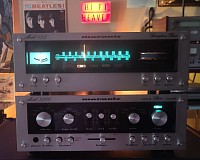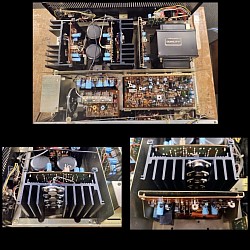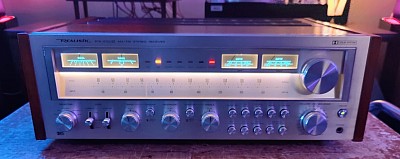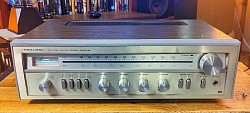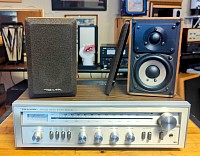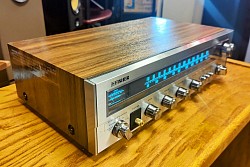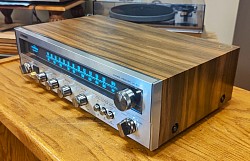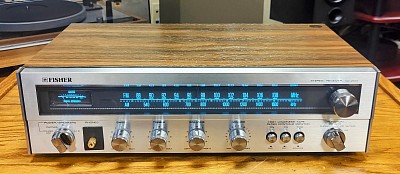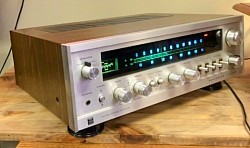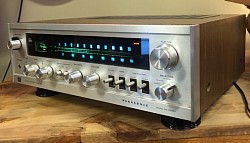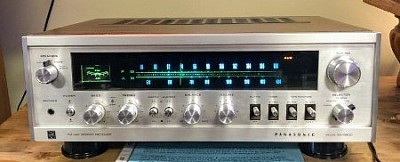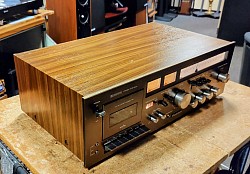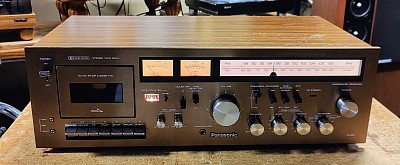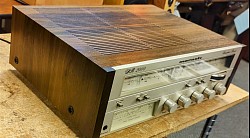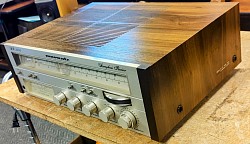Page 3 Receivers, Amps, Tuners, etc
Marantz 3200 & 112
preamp ('73-'76) and tuner $800
Properly cleaned, professionally restored and fully tested, this Marantz 3200 Control Center (preamp) is a fairly rare and lovely example of the available Marantz technology during the early-to-mid 70's.
Besides our usual thorough inspection, cleaning, testing, etc a major part of the bench servicing included a recap of the always important phono stage (the old tantalum capacitors were removed and replaced with modern film caps).
The simple yet unmistakable Marantz 3200 front facia design has just the right amount of knobs and controls. There are no redundant or obsolete controls; every function is readily usable. It will mate perfectly with almost any high quality stereo amp as part of a "typical" vintage stereo system.
Among its features, the 3200 has 2 phono inputs along with the tuner and aux inputs. Perhaps its best feature is revealed if you look at the 3200 as essentially two totally separate units (a preamp and a speaker selector) on one common chassis. Simply put, the speaker wire outputs of the amp connect to the speaker wire inputs on the 3200. This now gives the 3200 complete control of up to two pairs of speakers.
The Marantz 112 tuner was also cleaned, inspected, realigned and fully tested. The 112 tuner inherits the basic performance of the Model 125 and has a compact front panel size to match the 3200 and 140 listed above.
The FM front-end uses MOS-FET, and the IF circuit consists of one IC, three transistors, and three 2-element ceramic filters.
PLL is used in the MPX section, and in addition, mono / stereo automatic switching is provided.
The front end, IF stage and MPX circuit are each laid out on a separate board and covered by a completely shielded case.
Marantz; a different perspective...
More than any other person, Saul Marantz defined premium home entertainment. Driven by his passion for music and his accomplishments as a classical guitarist – accomplishments that led to a close friendship with Andres Segovia – he was never satisfied with the “hi fi” equipment of his day. So he built better; first in his basement, later in a factory. His talent for industrial design and his ability to infuse talented engineers like Sidney Smith and others with his vision resulted in legendary products: The Model 7 preamplifier. The Model 8 and, soon after, the 8B power amplifier. And insured that his company would remain a premiere name in the industry he helped establish.
In the '60’s. Marantz made multiple significant moves. NASA found the Model 9 stable enough to be used in tracking stations around the world as part of the famous Apollo space program. Marantz also decided to relocate to California within this decade. Most notably, in 1964, Marantz was acquired by SuperScope.
Fueled by financial backing, innovative product development and additional production facilities in Japan, Marantz experienced excessive growth and expansion in the 1970’s. It was also the decade of the famous “2200” receiver, which turned out to become the most successful receiver line in consumer electronics history.
To Marantz, perfect specifications and technical accomplishment count for nothing unless a product can unlock the power, the excitement, and the emotion of music. Their heritage of technical excellence means they can create components with the ability to communicate the scale, timbre, pitch, and dynamics—in fact, the very essence—of a recording. Every Marantz component is technically and cosmetically designed to complement the lifestyle of the listener.
++++++++++++++++++++++++++++++++++++++++++
++++++++++++++++++++++++++++++++++++++++++
Realistic STA-2100D
('79-'80) $1200
In excellent cosmetic and working condition, this Realistic STA-2100D has been extensively serviced and refurbished. This includes setting of the bias as per factory specs. There are also some new transistors on the power board. The case has a new veneer. Finally it went through a thorough bench testing.
Conservatively rated at 120 watts per channel, the STA-2100D (D = Dolby) was the replacement model for the earlier STA-2100. For the curious, online chatter about the differences between the two models is abundant. But, essentially, the biggest difference was the removal of the earlier STA-2100's toroidial transformer due to a successful patent infringement lawsuit from Pioneer against Tandy Corp (parent company of Radio Shack/Realistic). Tandy got away with the first design but Pioneer was pissed enough to slam the brakes on the next version. However, the 2100D still has a large standard laminated core transformer which, by itself, is certainly no slouch by any means.
Weighing 48 lbs and about 21" in width, the 2100D is a heavy, well-designed unit that was the 'Shack's top of the line. The 2100 and 2100D were their most powerful receivers in the very late 70's and early 80's.
There are four beautiful meters spread across the front panel, each backlit with subtle light green lamps. The panel also has large sculpted knobs, lots of beefy pushbuttons and switches that are carefully and handsomely laid out. The glass covers a slightly slanted section that houses the radio dial and function lamps.
It's truly a stunning design when viewed in person.
There are inputs/outputs for two turntables, two pairs of speakers, two tape in/out, aux, etc. As usual, it's recommended that if using one pair of 4 ohm speakers, do not run them at the same time if using a second pair of speakers. However, most all 8 ohm speakers are fine running two pairs of them at the same time.
Basic specs:
Power output: 120 watts per channel into 8 ohms
Frequency response: 15Hz to 25kHz
THD: 0.04%
Dimensions: 20.5"W x 7"H x 16.5"D
Weight: 48 lbs
Features:
~signal and tuning meters, also both
~right / left power meters,
~high-mpx filter, high and low filters
~two tape in/outputs (also dubbing 1-2 2-1 switch)
~two phono inputs
~aux input
~separate bass, midrange and treble controls,
~two turnover switches for treble and bass.
NOTE: Including this STA-2100D, all the high powered Realistic receivers were manufactured by Tandy Electronics. This includes the STA-2000, 2000D, 2100, 2300, 2080, 2200 and 2290. From about 1975 thru the mid 80's, Tandy Corp. made most of the Realistic receivers, as well as receivers for Concord and Cambridge Audio. It should also be mentioned that Tandy chosen by Pacific Stereo to build the top two, highly respected Concept receivers. Finally, except for that momentous patent lawsuit against Tandy, Pioneer never had anything to do with Realistic receivers.
Realistic STA-530 & Minimus 7
(1981) $250 (includes speakers)
In good condition, this Realistic STA-530 was first released by Radio Shack in 1981 at a list price of $200. Frankly speaking, this system is more intended for either a starter system or garage use. The faceplate is not mint but it's not bad either. The receiver itself works perfectly and don't let those 16 watts per channel fool you; it kicks butt (with the right speakers).
Speaking of the right speakers, it matches up perfectly with the included pair of Minimus 7 (with the desirable walnut cabinets.)
The STA-530 has all the inputs and outputs found on most receivers, it lacks for nothing in that category. Because the speaker wires require RCA leads, we'll throw in a pair of those too.
The Minimus 7 speakers are in very good cosmetic condition and excellent working condition, this pair has the most desirable walnut cabinets, spring clip terminals and Jyoto magnet yokes (the same that ADS used later on).
From the catalog: The Minimus 7 is little only in size, not in performance - it's a real giant in concert hall sound. The high compliance woofer element gives astounding bass and the dome tweeter produces crisp, clean highs. Careful acoustic design matches the two dynamic elements with the enclosure and damping materials - resulting in amazingly smooth, broad frequency response.
Specs:
Type: 2 way, 2 driver loudspeaker system
Frequency Response: 50Hz to 22kHz
Power Handling: 40W
Impedance: 8 ohms
Bass: 4" high compliance
Tweeter: 1" dome
Finish: walnut cabinet
Dimensions: 7"H x 4.4"W x 4.3"D
Weight: 4.5 lbs each
About Minimus 7...
If you're aware of just how important Radio Shack was in the history of vintage HiFi, you probably remember the world renowned, very cool and
incredible Minimus 7 bookshelf speakers. They were a perennial favorite at Radio Shack for over 30 years. Rated at 8 ohms with a max power range of about 40 watts, they were an incredible value back in the day...still are today!
The basic model folks remember is probably the steel cased version, but the all-time favorite version were the ones with the walnut cabinets. They added a sheilded "AV" variety when they started to carry the "Optimus" house brand. The Minimus 7 are surprisingly good speakers, especially considering the size. Sadly Radio Shack is gone. There were other labels attached to the Minimus 7, some were sold under the RCA brand. But, regardless, they've been gone for some years.
Today, the world is full of small, cheap speakers but the problem is simply that they often don't sound very good. There are all those little devices that people hook phones and laptops up to, but most of those speakers don't really move much air. Despite their tiny size, Minimus 7 speakers always pack a surprising punch. Add a small subwoofer and they are hard to beat at their low price point.
Finally, we assume (by now) that anybody involved with vintage HiFi knows the value and build quality of "The Shack's" gear during the 70's and 80's. You get more bang for the buck with most of their receivers and turntables.
++++++++++++++++++++++++++++++++++++++++
++++++++++++++++++++++++++++++++++++++++
NAD 705
preamp / receiver ('92-'95) 40 WPC $325
In very good cosmetic condition and fully operational, this NAD 705 (which falls in the middle of their receiver lineup), follows the NAD tradition of high performance and functional design.
The 705 is easily converted to an excellent preamp by simply pulling the jumpers on the back.
The 705, like all NAD amps (whether separate components or part of a receiver) feature their "Power Envelope" design. This enables them to deliver outputs well beyond their continuous-power ratings during the brief intervals required by music peaks. Essentially, despite its modest specification of 40 watts per channel (into 8 ohms from 20 Hz to 20 kHz at less than 0.03 percent distortion), the 705 is also rated to deliver from 90 to 160 watts per channel into loads of 8 to 2 ohms during program transients.
The 705 also has NAD's proprietary "Soft Clipping" circuit, which causes the signal waveform to round off smoothly near the maximum power level, minimizing the harshness associated with peak clipping. This feature can be selected or defeated by a small slide switch on the rear.
Lastly, the 705 is everything NAD claimed and a lot more receiver than its modest size and appearance would suggest. It's another worthy member of a long line of distinguished products.
Basic specs:
Power output: 40 watts per channel into 8 ohms
Frequency response: 20Hz to 20kHz
THD: 0.03%
Speaker load impedance: minimum 4 ohms
Dimensions: 16.5"W x 4"H x 12.5"D
Weight: 14.5 lbs
About NAD (New Acoustic Dimension)...
NAD was founded in England in the early '70s by Dr. Martin L. Borish, an electrical engineer with a PhD in physics. Its most famous product is the late-1970s NAD 3020, an integrated amp designed by Bjørn Erik Edvardsen, which was highly regarded by various magazines in Britain.
NAD gear was designed with a philosophy of focusing on the sound first. They purposely intended to include only genuinely useful features for aesthetically understated designs when compared to other competitors' products. They were there to perform, not to shine. Their vision allowed for a high-end sound and lower-end prices that resulted in a no-nonsense industrial design – amps and components were uniformly dark grey with small buttons popping out here and there. The aesthetic was definitely in contrast to the bombastic shiny metallic space-race instruments on display from Japanese brands of the time. But then again NAD was free to devote all of their development dollars to the sound quality of the amp, and not to machining gorgeous tuning knobs from pure ingots of aircraft-grade aluminum.
From early on, NAD focused on ensuring high levels of dynamic headroom in their amps; meaning that a lower-rated, sustained power amp could spike to much higher wattages to handle musical transients, ensuring clean playback at top volume. It also means that when you have a NAD, you’re likely getting more power than the specs offered. They were one of the first audio manufacturers to outsource the manufacturing of its products to electronics factories in east Asia. NAD was acquired by the Danish firm AudioNord in 1991 and subsequently sold in 1999 to the Lenbrook Group of Pickering, Ontario, Canada
++++++++++++++++++++++++++++++++++++++++
++++++++++++++++++++++++++++++++++++++++
Fisher MC-2100
(1978) 12 WPC $250 (perfect)
Obtained locally and in pristine cosmetic and operating condition, this beautiful Fisher MC-2100 receiver was produced during the time when Fisher Corp had been purchased by *Sanyo of Japan.
Although rated at a conservative 12 watts per channel, this receiver has a well built amplifier section and has no problems driving an efficient pair of 4 ohm speakers.
The walnut veneer case is perfect. The silver faceplate and blue lights on the dial glass are typical of the pure 70's vintage design.
It has inputs for 2 pairs of speakers, phono and tape in/out. The tape input doubles as an auxiliary input as well.
Basic specs:
Power output: 12 watts per channel into 8Ω (stereo)
Frequency response: 20Hz to 20kHz
THD: 1%
Dimensions: 17"W x 11"D x 5"H
Weight: 12 lbs
*Note:
Fisher designs were originally from Avery Fisher himself. After he sold the company to Emerson, that name faded away. The Fisher name was revived and developed by Sanyo after they, in turn, bought it from Emerson. Sanyo reached into their very deep pockets and took over the slumping Fisher brand and did a great job of bringing Fisher back into the mainstream. Of course, prior to all that, the name "Fisher" has always been synonymous with high fidelity leadership since the 60's when Avery Fisher turned the audio world on its ear with his early tube units (like the famous Fisher 500C and others). Alas, all things had to end and Avery Fisher let go of his beloved company. Over the years, the brand has both flourished (to some) and floundered (to others). However, it's generally agreed that most of the Fisher branded gear made by Sanyo (from the mid-70's to early 80's) is well made.
++++++++++++++++++++++++++++++++++++++++
++++++++++++++++++++++++++++++++++++++++
Panasonic SA-5800
(1972) 23 WPC $350
In very good cosmetic and operating condition, this Panasonic SA-5800 receiver hit the market in 1972 and retailed for $259.95. It was engineered by Matsushita Electric Industrial Co. of Japan. This was during the time right before Matsushita split off the Panasonic brand and added their "mid-fi" Technics branded gear.
NOTE: most of the information below is credited to the "Classic Receivers" website.
Matsushita’s engineers were able to achieve an appealing mix of features and performance capabilities in a relatively inexpensive receiver. And, they included them in a very nicely designed package. The only qualms I have with the design are the somewhat strange looking selector switch knobs. It produced 23 watts per channel into 8 ohms when powering both channels (27 watts per channel when powering each channel separately).
The face plate is made of heavy, extruded, light-gold anodized aluminum. The SA-5800 was part of Panasonic’s receiver lineup in the early 1970’s that included the top-of-the-line SA-6500, the SA-6200, the SA-5800, the SA-5500, and the SA-5200. Panasonic marketed the SA-5800 with the tagline: “Get an Earful of Pure Sound!” Their brochure stated that the SA-5800 was, “The well-bred child of a close knit family of electronics wizards.”
In fact, Panasonic had a number of humorous marketing phrases such as:
“…More than sufficient to engulf your whole house in a sea of crystal pure sound.”
“Whether you want to lose yourself in the driving rhythms of Jazz or the New Rock, or slide into that warm, classical world, let the SA-5800 be your magic carpet.”
“Its vibrant power will set a crowd swinging to the throbbing beat, or gently soothe the meditative individual.” It was hard to pass up a receiver that can do all that!
The Panasonic SA-5800 has the usual features for a moderately priced stereo of the time. Bass and treble controls, high filter, loudness control, a small tuning strength meter, and of course, balance and muting controls. The tone controls are concentric knobs, permitting individual channel adjustment of both bass and treble. The tuning meter is dual function. When tuning AM, the meter will swing further to the right the stronger the signal. When tuning FM, it becomes a center tuning meter and the closer the meter to center the stronger the FM signal.
The dial face includes an appealing green, linear, slide rule tuning dial along with amber frequency numbers contrasting against a black backdrop. The program and stereo indicators are all red. One cool feature of the SA-5800 is that the dial pointer will glow a marigold color when it is perfectly centered on a signal. Otherwise it will remain unlit.
The FM section of the SA-5800 is very good. It uses a MOS-FET design with a 4-gang tuning capacitor. The whole circuit is on a sub-chassis that is completely shielded to reduce interference and distortion from power hum. In fact, the SA-5800 has very good IHF sensitivity across the dial. Most manufacturers at the time optimized their tuner sensitivity to the 98 MHz range which was the “official” frequency to test for sensitivity. Sensitivity would then fall off to lower performing levels at either end of the frequency range. Matsushita didn’t do this which is why their FM tuner is so good. The signal to noise ratio was published as 60dB but was measured by two different testers at the time and measured 64dB and 72dB which is very good.
The phono section isn’t bad either. A leading audio magazine of the time said: “…in playing records…we were aware of a certain sweetness and liveliness of detail both in big orchestral passages and in the reproduction of solo instruments“.
Basic specs:
Power output: 23 watts per channel into 8 ohms
Frequency response: 15Hz to 65kHz
THD: 0.5%
Speaker load impedance: 4 ohms minimum
Dimensions: 16″W x 5.5″H x 14″D
Weight: 24 lbs
++++++++++++++++++++++++++++++++++++++++++
++++++++++++++++++++++++++++++++++++++++++
Panasonic RA-6500
('73-'78) 12 WPC $150
An amazing find, not exactly rare nor that powerful but...this particular Panasonic RA-6500 was obtained from the original owner and is in pristine condition. Upon its release in the late 70's it retailed for a hefty $390.
Slightly bigger than the "average" receiver with a gorgeous design, its bronze faceplate (with white silkscreen lettering), walnut veneer case, cassette deck player/ recorder, FM, phono, Aux, etc are all neatly packaged...the RA-6500 has a nice place in vintage HiFi history from Japan.
The rated power of "only" 12 watts per channel is misleading. The RA-6500 can drive two pairs of efficient speakers.All meters, knobs, switches, inputs and outputs are working as intended. The twin meters have a dual purpose: one meter will indicate tuning station strength in FM mode then, when in recording mode they show L/R recording levels.
The cassette deck within this unit is sketchy at best. However, the phono, FM and AUX (for streaming) are all working great. This would make an excellent beginner setup or workshop unit.
There is a front input for a separate microphone for mixing in any function (you can "sing along" in FM, Aux or Phono modes)
++++++++++++++++++++++++++++++++++++++++
++++++++++++++++++++++++++++++++++++++++
Marantz SR-2000
('79-'81) 30 WPC $420 (perfect)
This Marantz SR-2000 is in absolutely pristine cosmetic condition, fully serviced and fully operational. Because of what Marantz called their *True-Power amp design, the SR-2000 easily punches above its rated power of 30 watts per channel.
The front faceplate design is unique among the many receivers introduced in the early 80's. A brushed satin finish covering the entire aluminum plate is complemented by knobs with the same metal finish as the faceplate. There are two wide and well lit (easy to read) power meters along with a very cool illuminated tuning dial cursor; spin the flywheel and the well lighted cursor moves across the dial.
The pristine, real timberwood walnut veneer case has well-designed, attractive vents carved into the top of the case.
This beautiful receiver was near the end of the era for Marantz even though they were still owned by Superscope. Regardless of random chatter out there, this series was at the tail end of the "real" Marantz just prior to the beginning of the Philips ownership of the brand.
The most well known and exclusive Marantz feature on the SR-2000 is the famous "Gyro-Touch" tuning flywheel.
NOTE: After Philips assumed full control of the Marantz product line, one of the first things that was eliminated was the Gyro flywheel; it was replaced by a typical knob. Bummer.
*True-Power:
The SR-2000 amp section has a direct-coupled, full complementary symmetry output stage. Essentially, this type of build is more costly than the quasi-complementary outputs of many other receivers. The direct-coupled design offers significant performance improvements in terms of linearity and lower harmonic distortion.
The looks are absolutely gorgeous and it produces a very open soundstage. It also has versatile separate tone controls for bass, mid range and treble.
Although the build quality is probably not as high as the 22xx series it still has all the hallmark signatures and styling of the earlier Marantz products.
As mentioned above, this unit is rated at 30 watts per channel into 8 ohms and yields another 25% more power with 38 watts per channel at 4 ohms. The beautiful, large backlit power meters peak out at 60 WPC 8 ohms and 120 WPC at 4 ohms.
Basic specs:
Power output: 30 watts per channel into 8 ohms
Frequency response: 15Hz to 50kHz
Total harmonic distortion: 0.04%
Dimensions: 18.4"W x 6"H x 12.8"D
Weight: 18 lbs
About Marantz and Philips...
The 1964 sale to Superscope would be the first of several changes of ownership for Marantz: in 1980 Superscope sold its 50% holding in Marantz Japan, and trademark and marketing rights worldwide (excluding the USA and Canada) to Dutch company Philips.
The story goes that Philips USA didn't want a fifth brand – it already had Sylvania, Philco, Philips and Magnavox 'on the go', as I explained in my piece earlier this year marking the end of Philips' consumer electronics activities – and it would be many years before Marantz was again completely united.
By the time Philips effectively took over selling Marantz to most of the world, the company had already been joined by someone set to be a significant figure in its future development.
A long time associate of Saul Marantz, a fellow named Ken Ishiwata, moved to Marantz Europe, having been headhunted from Pioneer in 1978, as technical coordinator.
He was sent back to Japan for three months to learn about the Marantz way, and he once said "The Marantz understanding of amplifiers was way beyond me: the company spent five years training its engineers in the American way of making amplifiers."
For the past 46 years, Ishiwata and Marantz have been inextricably linked: he was there when Philips (and thus Marantz) started making their first CD players, starting with the CD-63.
Ishiwata said "That was another great opportunity for me: I had been working with analog audio until then, and didn't know anything about digital. I learned so much from the Philips engineers."
Also around this time Ishiwata was again contacted by Saul Marantz (by then in his 70's) who said "I have done as much as I can with mono and stereo LPs; now it's your turn to do something with compact disc."
And the beat goes on...
++++++++++++++++++++++++++++++++++++++++++++++
++++++++++++++++++++++++++++++++++++++++++++++
